Filter Forge: Aging a photo - quickly and easily (lesson)
The network has published a huge number of tutorials describing the most diverse ways of aging photos. I bring to your attention one more - with the help of Photoshop and the Filter Forge plug-in and I will deliberately not use ready-made textures and brushes. The result is this picture:
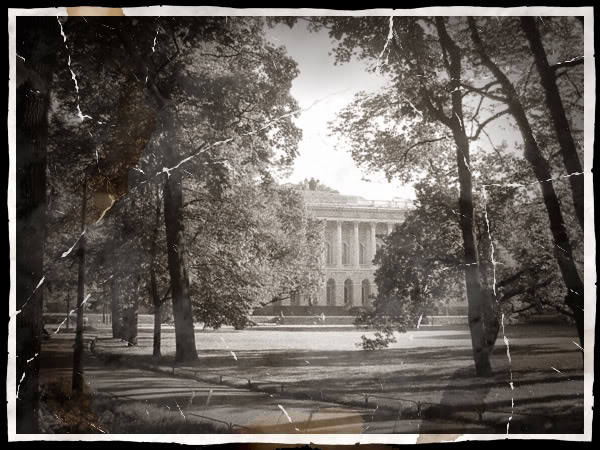
If you do not have Filter Forge plug-in, download it on the official developer site http://www.filterforge.com/download/ . Run the Filter Forge Setup.exe installer (for Windows) or Filter Forge Setup.dmg (for Mac OS X) and install the program on your computer. In Photoshop, a new item will appear in the Filter> Filter Forge menu (you may have to restart Photoshop).
')
Launch Photoshop and open the original image Ctrl + O. I used a photo that was taken in St. Petersburg using a Canon A520 camera. In my photo there are no details that would discord with the style "antique", for example, antennas on buildings, cars or modernly dressed people. Take a close look at your original image for extra details. If there is, then you have to spend some time removing them. I think the network has a lot of lessons on this topic.
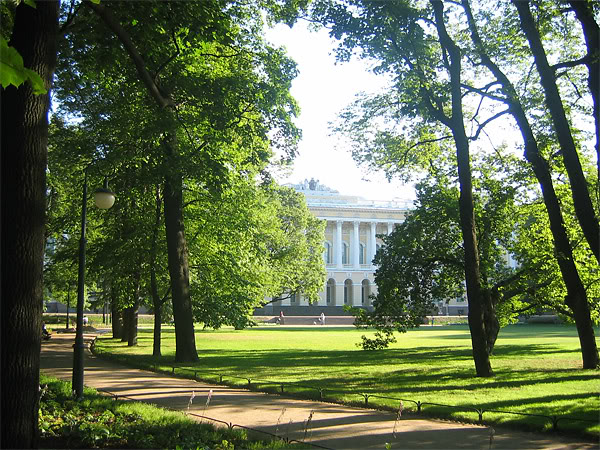
Add a little contrast to the image: Image> Adjustment> Brightness / Contrast. I chose the Contrast value: +30.
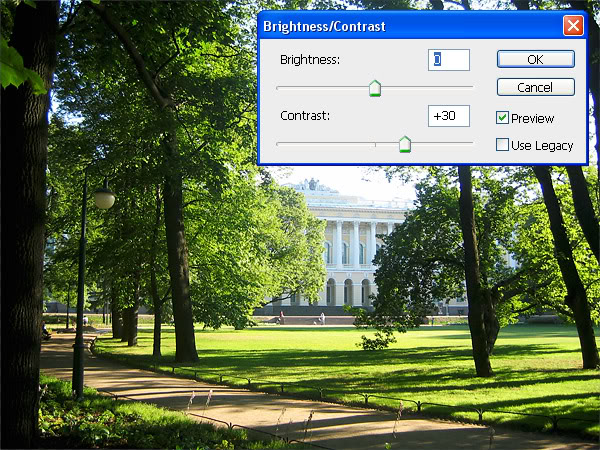
In Photoshop, run the Filter Forge plugin (Filter> Filter Forge). Then go to the Old Photo filter page and click the "Open in Filter Forge" button. The filter download starts (38.7 KB).
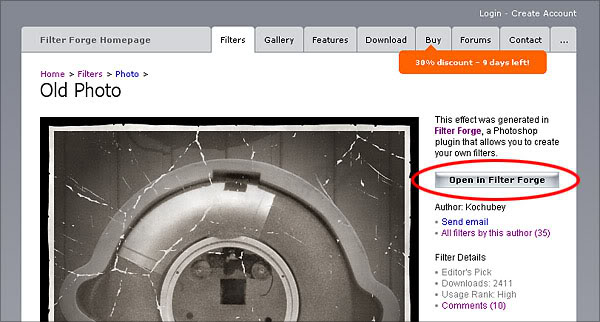
Similarly, download the Coffee Stain filter. It will be useful to us later - with its help we will make spots.
And again we select Old Photo (category Photo) in the list of filters.
Now we will select the most suitable parameters for our picture. To begin with, I try to apply the presets that already exist (the Presets tab) - double-clicking on the thumbnail applies the effect to our image. I found something suitable, but I also want to twist the parameters. I switch to the Settings tab and start moving the sliders.
There is another great thing - a random value generator (Randomizer) and the Next Option button (Next Variant). By clicking on it, the program generates parameter values randomly. You can simply press this button until you hit the right combination.
It turned out this picture:

Now in Photoshop create a new layer; call it, for example, “Stain” and run Filter Forge (in the menu Filter> Filter Forge). Select the filter “Coffee Stain” - it is in the category “Misc” in the texture section.
Small lyrical digression: You probably noticed that in the category list of the Filter Forge program there are items with the same name, for example Misc, Frame, Patterns. This is due to the fact that in Filter Forge all filters in the library are divided into 2 types - textures (the upper part of the list of categories in the program) and effects. Details can be read here (in English). Thus, we will search for the “Coffee Stain” filter in the “Misc” category at the top of the list.
So, apply the "Coffee Stain" filter to our "Stain" layer.
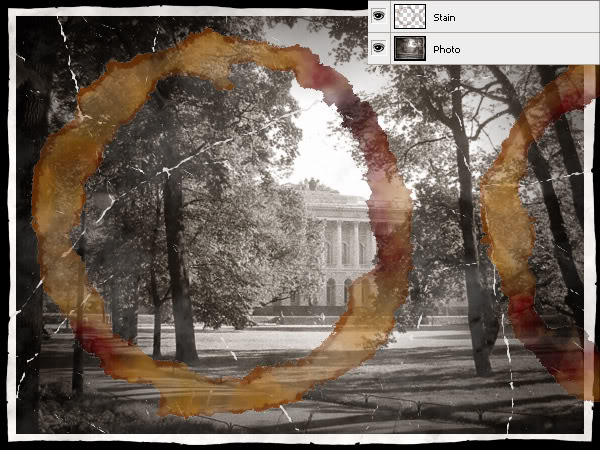
Similarly, we create several more layers with different spots. Feel free to twist the filter settings :)
Now move the stained layers to the places you like (using the Move Tool). For each layer, select the blending mode (Blending mode) and the degree of transparency (Opacity). And erase the extra segments of the spots (Erase Tool).

Well, actually, that's all. See the result:


If you do not have Filter Forge plug-in, download it on the official developer site http://www.filterforge.com/download/ . Run the Filter Forge Setup.exe installer (for Windows) or Filter Forge Setup.dmg (for Mac OS X) and install the program on your computer. In Photoshop, a new item will appear in the Filter> Filter Forge menu (you may have to restart Photoshop).
')
Step 1. Original image
Launch Photoshop and open the original image Ctrl + O. I used a photo that was taken in St. Petersburg using a Canon A520 camera. In my photo there are no details that would discord with the style "antique", for example, antennas on buildings, cars or modernly dressed people. Take a close look at your original image for extra details. If there is, then you have to spend some time removing them. I think the network has a lot of lessons on this topic.

Step 2. Add contrast
Add a little contrast to the image: Image> Adjustment> Brightness / Contrast. I chose the Contrast value: +30.

Step 3. Apply the filter “Old Photo”
In Photoshop, run the Filter Forge plugin (Filter> Filter Forge). Then go to the Old Photo filter page and click the "Open in Filter Forge" button. The filter download starts (38.7 KB).

Similarly, download the Coffee Stain filter. It will be useful to us later - with its help we will make spots.
And again we select Old Photo (category Photo) in the list of filters.
Step 4. Selection of filter parameters
Now we will select the most suitable parameters for our picture. To begin with, I try to apply the presets that already exist (the Presets tab) - double-clicking on the thumbnail applies the effect to our image. I found something suitable, but I also want to twist the parameters. I switch to the Settings tab and start moving the sliders.
There is another great thing - a random value generator (Randomizer) and the Next Option button (Next Variant). By clicking on it, the program generates parameter values randomly. You can simply press this button until you hit the right combination.
It turned out this picture:

Step 5. We make stains with the Coffee Stain filter
Now in Photoshop create a new layer; call it, for example, “Stain” and run Filter Forge (in the menu Filter> Filter Forge). Select the filter “Coffee Stain” - it is in the category “Misc” in the texture section.
Small lyrical digression: You probably noticed that in the category list of the Filter Forge program there are items with the same name, for example Misc, Frame, Patterns. This is due to the fact that in Filter Forge all filters in the library are divided into 2 types - textures (the upper part of the list of categories in the program) and effects. Details can be read here (in English). Thus, we will search for the “Coffee Stain” filter in the “Misc” category at the top of the list.
So, apply the "Coffee Stain" filter to our "Stain" layer.

Similarly, we create several more layers with different spots. Feel free to twist the filter settings :)
Step 6. Putting spots in places
Now move the stained layers to the places you like (using the Move Tool). For each layer, select the blending mode (Blending mode) and the degree of transparency (Opacity). And erase the extra segments of the spots (Erase Tool).

Result
Well, actually, that's all. See the result:

Source: https://habr.com/ru/post/61634/
All Articles